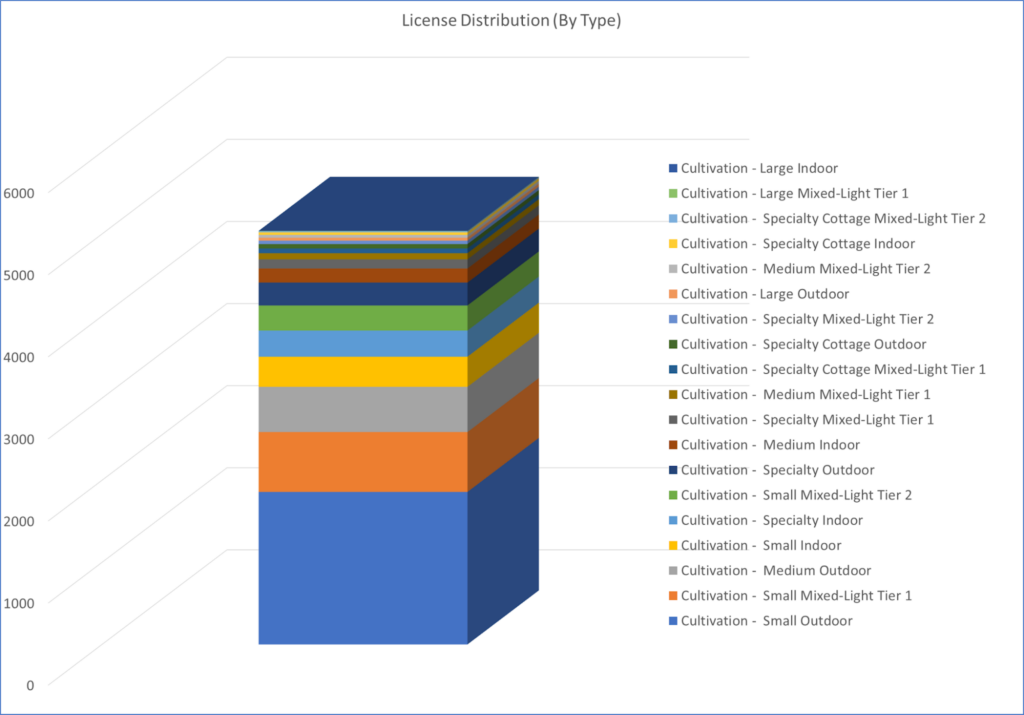All data displayed below were pulled from the California Department of Cannabis Control Cannabis Unified License Search tool, accessed on January 29, 2024.
Overview
At a very basic level, the DCC database tells us how many cultivation licenses are in the state, and how many total cultivation licenses there are. From this information, we can tell you how each county that allows cultivation compares to each other and to the state total.
This is a good starting point for identifying which counties in the state host licenses and how they compare with each other, but this information is of limited use. Some counties permit more large licenses, and some permit smaller licenses, with everything in between. Let’s take a look at the different types of licenses and the data we can play with to make different kinds of geographical comparisons.
Cultivation License Types
There are 19 different cultivation license types in the DCC database, excluding processing and nursery licenses. We also exclude microbusiness cultivation, which is extremely rare and deserves its own special attention as a license type.
Each license type contains a combination of three distinct types of information: maximum canopy (“size”), degree of enclosure, and energy use. This information is very important for local permitting, as it tells local planning departments information about land use that informs their permitting processes.
Information in License Types: Sizes, Canopy, and Land Use
Size is defined by the maximum canopy permitted by license types, in square feet and acres. There are five size types, which you can think about as “Large,” “Medium,” “Small,” “Extra Small,” and “Extra Extra Small.”
The first three size types are named exactly that way by the Department of Cannabis Control. “Extra Small” is called “Specialty.” And “Extra Extra Small” is actually called “Specialty Cottage.”
Size is a relatively straightforward type of information, but as you can see from the table it’s not uniform even within categories. This information is limited by the fact that licensees may not cultivate their maximum canopy, for any number of reasons.
So license type information tells us about maximum size potentials, rather than currently accurate estimates of how much space is taken up by cannabis cultivation across the state. With that said, here’s a table showing California’s aggregate data for number of licenses and maximum canopy, by cultivation license type.
| Cultivation License Type | # | Max Canopy (sqft) | Aggregate Max Canopy | Max Canopy Acreage |
| Cultivation – Specialty Cottage Indoor | 31 | 500 | 15500 | 0.36 |
| Cultivation – Specialty Cottage Mixed-Light Tier 1 | 57 | 2500 | 142500 | 3.27 |
| Cultivation – Specialty Cottage Mixed-Light Tier 2 | 13 | 2500 | 32500 | 0.75 |
| Cultivation – Specialty Cottage Outdoor | 54 | 2500 | 135000 | 3.10 |
| Cultivation – Specialty Indoor | 318 | 5000 | 1590000 | 36.50 |
| Cultivation – Specialty Mixed-Light Tier 1 | 112 | 5000 | 560000 | 12.86 |
| Cultivation – Specialty Mixed-Light Tier 2 | 42 | 5000 | 210000 | 4.82 |
| Cultivation – Specialty Outdoor | 279 | 5000 | 1395000 | 32.02 |
| Cultivation – Small Indoor | 367 | 10000 | 3670000 | 84.25 |
| Cultivation – Small Mixed-Light Tier 1 | 729 | 10000 | 7290000 | 167.36 |
| Cultivation – Small Mixed-Light Tier 2 | 306 | 10000 | 3060000 | 70.25 |
| Cultivation – Small Outdoor | 1858 | 10000 | 18580000 | 426.54 |
| Cultivation – Medium Indoor | 171 | 43560 | 7448760 | 171.00 |
| Cultivation – Medium Mixed-Light Tier 1 | 75 | 22000 | 1650000 | 37.88 |
| Cultivation – Medium Mixed-Light Tier 2 | 34 | 22000 | 748000 | 17.17 |
| Cultivation – Medium Outdoor | 551 | 22000 | 12122000 | 278.28 |
| Cultivation – Large Indoor | 1 | 22000 | 22000 | 0.51 |
| Cultivation – Large Mixed-Light Tier 1 | 4 | 22000 | 88000 | 2.02 |
| Cultivation – Large Outdoor | 36 | 43560 | 1568160 | 36.00 |
The Trouble with Small License Types
At this point in time, small license types present especially problematic information. Until January 2023, the largest cultivation firms in the state actually held mostly small licenses, “stacked” into the landscape to make up very, very large farms.
This is because between January 2018 and 2023, the state had a moratorium on “Large” license types, to give small and medium enterprises a head start on big cannabis agribusiness. The rules specifically stated that no firm could own more than one Medium license type, but they did not specify whether firms could collect as many Small (or smaller) licenses as they wanted. This “stacking loophole” allowed well-capitalized cultivation interests to eliminate the head start that the state had intended.
At this time, very few big cultivation firms have consolidated their stacked Smalls into Large licenses – at least, as far as the database can tell us. We expect data about Small licenses to change quite a bit in the next few years now that they can be consolidated into Large license types.
The following image illustrates the predominance of “Small” license types in the DCC database. It’s very important to understand that this reflects the large firms that stacked small licenses and may soon transition these to the Large license type.

For our third post (California Cultivation: Degree of Enclosure and Energy Use), we want to show another way to evaluate different types of California cannabis cultivation: degree of enclosure and energy use.


0 Comments